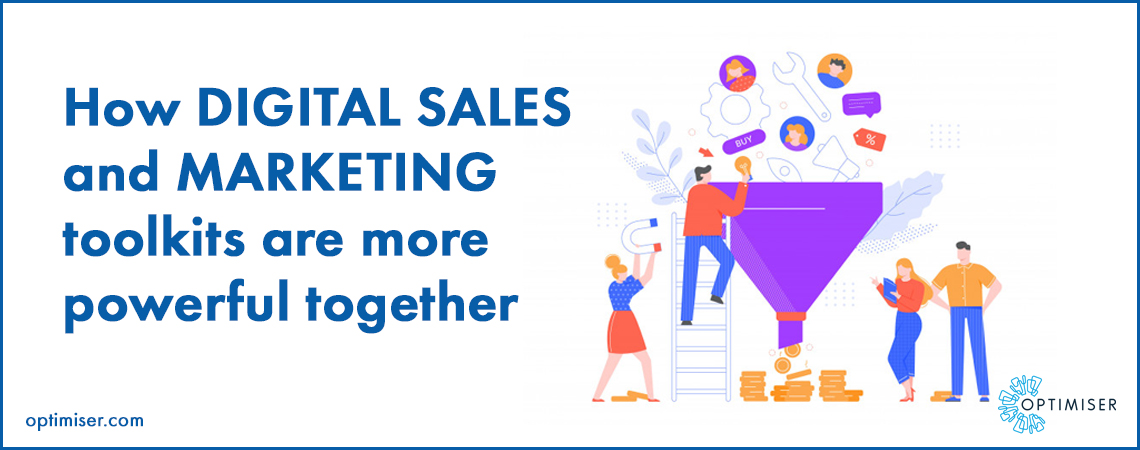
How digital sales and marketing toolkits are more powerful together
What’s in the marketing toolkit?
How marketing and sales teams work together
How marketing and sales tools help teams work together
Dependent on your business goals and game plan, your sales and marketing toolkits can perform different functions. The nature (and benefit!) of cloud-hosted business software is that it is fully flexible and expandable: you’ll never find your toolkit falling short of your expectations, whether your business undergoes rapid growth, a change in directions, or a market fluctuation.
What’s in the sales toolkit?
Optimiser’s sales toolkit is fully integrated into the core CRM platform, encouraging sales teams to create strong customer relationship building techniques that play a key part in increasing deal closures and revenue. The key digital tools for a salesperson are:
- Pipeline: the pipeline is a tool in which sales reps can guide projects and leads through a linear process, map out key tasks or communications, and collaborate with colleagues to close deals. The pipeline not only allows for a highly streamlined workflow, it helps salespeople to identify points in the funnel where time and finance-saving automations can be added.
- Invoicing: A pretty self-explanatory tool, digital invoicing allows sales and finance teams to work together to produce accurate and branded invoices. By attaching invoices to their respective Contact or Account, salespeople can use this information to follow-up, generate proxy sales and understand a particular Account’s purchasing habits in greater detail.
- Automations: Automations are pieces of code using artificial intelligence to manage certain business processes without the need for manual intervention. Usually automations are applied to the parts of the sales process that involve formulaic or repetitive processes, and are great at saving salespeople valuable time in lead nurturing, follow-ups, and moving prospects along the sales funnel.
What’s in the marketing toolkit?
While most peoples’ minds may go right to social media when they think about digital marketing, it may surprise you to find out that email marketing is still one of the most effective and relied-upon methods of reaching an audience. Key features of a marketing toolkit are:
- Analytics: Understand exactly who is visiting your website and where your biggest sales are coming from. Of course listening to what your marketing data is telling you about your business will help you achieve more, but analytics in marketing do all of the leg-work for you- cleaning, interpreting and reporting on data to save you valuable time resources.
- Email marketing: As just mentioned, email marketing still outranks social media and SEO marketing by a rather large margin. Not only does email marketing allow segmentation and personalisation of messages like no other platform can offer, it offers an ROI of up to 4400%. To grow your revenue while reducing outgoing IT expenditure, email marketing is your digital marketing must-have.
- CRM: Integrated CRM tools ensure that marketing efforts remain customer-focussed and do not lose sight of what your target audience wishes to see from your brand. Optimiser’s integrated customer tools include Pipeline, Analytics, Contacts, Accounts and Calendar for streamlining the workflow and creating a united approach to creating brand relationships.
How marketing and sales teams work together
Sales is a more direct process in which the salesperson liases directly with the lead and nudges them in stages along the company pipeline to secure a deal. The process of making a sale can be very long, involve multiple company personnel and many conversations in order to finalise.
In contrast, marketing is much more broad: a continuous flow of brand to consumer communication that increases awareness of the product or service in the target audience. Dependent on the size of the company, marketers can have communication with the consumer but it is less likely and will usually happen once with many customers rather than multiple conversations with just a few.
.jpg)
These distinct differences in operating procedure can create a rift between the actions of marketing and sales: the salespeople don’t know what the overall marketplace reaction is to the product or service, where the leads are coming from and how best to communicate with them based on this information. On the other side, marketing does not get to see which leads go on to result in closed won deals and as a result do not know where their marketing tactics are the most valuable or beneficial.
“I do believe the modern sales leader has to be a marketer”
Matt Gorniak
By uniting the two teams in the digital sphere, you can ensure that the customer journey is treated holistically from start to finish, and that each lead is handled with consideration for its potential for value and demographic niche: increasing overall company revenue in the long run.
How marketing and sales tools help teams work together
Integrated digital tools that encompass sales, marketing and a core CRM allow all of your business data into a single database. This helps keep all information relevant and accurate: eliminating time lost on data share and reducing the risk of false interpretation and mistakes.
The core database including individual user storage enables the marketing and sales team to understand their audience better through each stage of the customer journey. By sharing key information about demographics, contacts and accounts, marketing can target focus groups and cross-campaigns that target the best sales clients.
.jpg)
When marketing and sales are working together to optimise the customer journey, the full experience and quality of the funnel is considered holistically, leading to a more effective lead pipeline overall. By providing a tailored experience, the business will see an increase in conversion and retention rates overall: boosting productivity and revenue.
Optimiser is a comprehensive CRM software company, providing businesses a customisable solution to their personal goals for sales, productivity, and growth. Powerful integrated modules include lead management software, a B2B sales toolkit, automated marketing suite and more for sale under a single subscription. Try Optimiser’s CRM software demo with access to the full Enterprise Licence FREE for 30 days, and find out how you can skyrocket productivity in just one month!

30 days free trial. No credit card required
 One powerful platform
One powerful platform
 Simple to use
Simple to use
 Comprehensive
Comprehensive



